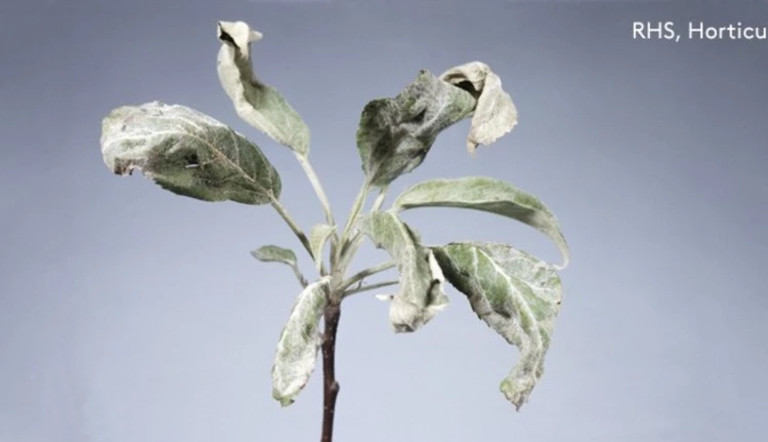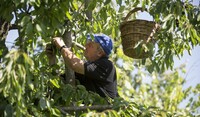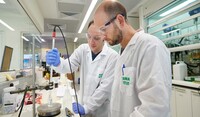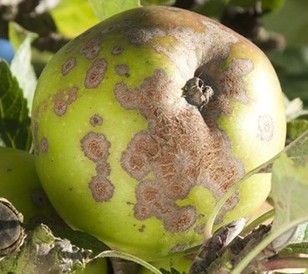
Tackling apple and pear diseases

Apple Scab and Pear Scab (Black Spot)
Apple scab Venturia inaequalis, and the closely-related pear scab Venturia pyrina, are major fungal diseases affecting tree fruit crops.
Scab is spread by airborne spores causing dark green, velvety spots on leaves and dark, scabby blotches and cracks on the fruit. The lesions affect the appearance of the fruit and seriously reduce the crop’s commercial value. In addition, the cracks leave the fruit prone to rotting which affects the storage capability. On young shoots the cracking can also provide entry points for canker.
Control is via fungicides such as Captan-based products which may need to be applied as often as 15 times each season.
Leaf Blotch
Leaf Blotch is fungal disease spread by spores from various Alternaria species such as A. mali and A. alternata. The disease overwinters on fallen leaves before the primary infection period in the late spring which is followed by further secondary outbreaks through the summer. On leaves the disease symptoms begin as brown spots about 5mm across before turning grey while fruit lesions appear as small, dark pimples. Severe infections can cause leaf fall of up to 50% defoliation by mid-summer and cause a reduction in fruit yield and quality. Captan-based protectants can be used especially in regions with hot, wet summer climates which help the disease to thrive.
Pear Brown Spot
A disease of growing importance in pear is Brown Spot which is caused by the fungus Stemphylium vesicarium.
The fungus infects leaves, fruits and twigs and causes necrosis and fruit rot appearing as brown spots on the skin. Severe damage to pear crops has been seen in southern Europe but it has also been identified as an emerging and serious problem in orchards in northern Europe - particularly in the Netherlands and Belgium.
Fungicides such as Captan-based products can be applied as a preventative measure but there is no curative action so again vigilance for the emerging disease is paramount.
Apple Powdery Mildew
The powdery mildew fungus Podosphaera leucotricha is one of the most important diseases in commercial apples - reducing yield and quality.
The mycelium overwinters in buds and the primary mildew appears on pink blossom or shoot tips at petal fall. As the spring and summer seasons progress mildew spreads to growing shoots. This secondary phase can infect leaves and produce sporing mildew colonies in less than a week.
Control becomes increasingly difficult as the primary mildew colony spreads so strategies depend on routine spraying and careful monitoring. Monitoring is essential to establish the disease level before matching the amount of active ingredient applied and spray interval.
Where more than 2% of blossoms or shoots are covered in the primary phase, action should be taken. For the secondary phase, with under 10% mildewed shoots it may be possible to reduce fungicide inputs if the weather is hot and dry and fungal growth is slow.
Systemic Fungicides such as Bupirimate can provide curative and protectant activity.
Apple Replant Disease
Replant disease is caused by species of Pythium - a genus of parasitic oomycotes or certain Phytophthora species like cactorum. The pathogens can be present in non-sterilised soil and invades the root of newly-planted trees causing poor growth and cropping.
Soil fumigation before planting is the most effective way to treat the disease. But cultural methods, such as lining the planting hole with peat or mulch or placing new trees in fresh ground along the alleyways of the previous orchard, will also reduce contamination from old planting sites.
Apple Canker
Caused by the fungus, Neonectria ditissima, or Neonectria galligena the disease attacks tree bark at any wound sites and then appears as dead areas which are circular- or oval-shaped. Red or white fruiting bodies may also emerge. The disease can kill young shoots and fruiting spurs in a single season but on larger branches cankers are perennial. The bark is lost in these older cankers where raised edges develop around a dead-wood centre. Eventually the canker will cause the loss of the branch.
Controlling the disease begins with careful monitoring during winter pruning and watching for shoot dieback in the spring.
Growers can protect small wounds with fungicides such as Captan-based products. In the winter growers cut out larger infections and these can be treated with a wound cover product.
Gloeosporium and Colletotrichum Rot
These fungal pathogens survive the winter on mummified fruit or within cankers before producing spores throughout the growing season. The spores invade fruit through lesions and cause rotting once the fruit is in storage, leading to significant losses. The rot is brown and circular and may form marked concentric rings as it spreads from the site of infection. Over time, other symptoms may include pink, orange or cream-coloured pustules. The amount of infection is linked to rainfall, historical prevalence and the fruit cultivars’ mineral composition. Control can be achieved by removing overwintering sites and using Captan-based fungicides. The mineral composition should also be tested particularly in cultivars like Cox which are more susceptible to fungal rots.
Image Gallery
Related Articles

How the Cazado® Launch Embodies Value Innovation

From Market, For Market: How Grower Feedback Drives Innovation

